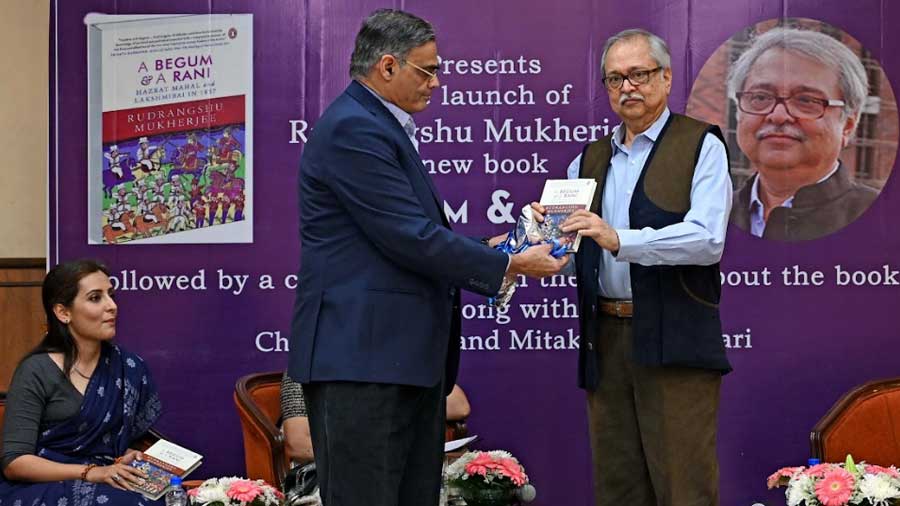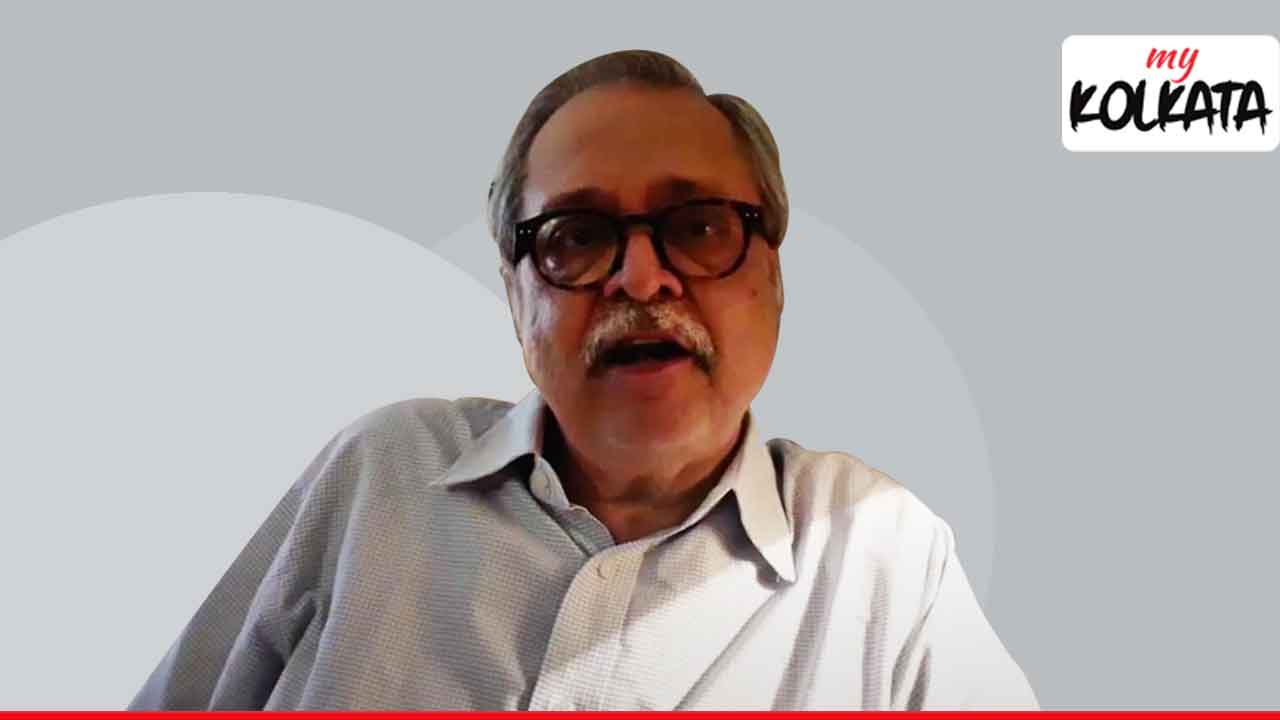It is impossible to love Satyajit Ray’s cinema and not rate one particular film – Shatranj ke Khilari – as being among his best work. Professor Rudrangshu Mukherjee – chancellor of Ashoka University, where he also teaches History – feels the same way. At the 2023 Bichitra Pathshala Lecture – previous editions of which have featured eminent speakers like Jawhar Sircar and Ananda Lal, among others – Mukherjee held his audience spellbound with a detailed talk on the iconic filmmaker’s remarkable ability to marry creativity and undistorted history in his cinema. Titled History in Ray’s Films: Some Episodes from Shatranj Ke Khilari and Other Films, the lecture involved a special focus on Wajid Ali Shah – the deposed Nawab of Awadh who spent the last three decades of his life in Calcutta – and the manner in which Ray approached the depiction of the annexation of Awadh in Shatranj Ke Khilari.
Before Mukherjee began his lecture, he was felicitated on behalf of Bichitra Pathshala by visual artist Soumyadeep Roy, whose art combines stories and histories, and who painted a scroll measuring 18 feet x 4 feet as a tribute to Wajid Ali Shah, displayed at the Sibtainabad Imambara at Metiabruz on the occasion of the deceased Nawab’s 200th birth anniversary.
Vaijayanti Bose, the president of Bichitra Pathshala — an organisation that, since 2010, has aimed to make learning more exciting for children, through cinema, video and moving images – gave the audience a glimpse into what to expect from Mukherjee’s lecture. “The prolific writer and reputed historian will take us back to 19th-century Awadh, to visualise Nawab Wajid Ali Shah nurturing the Ganga-Jamuni tehzeeb, and speaking about Hindu-Muslim amity — the need of the hour for us today.” She reminded the audience about how Lucknowi culture blossomed under Wajid Ali Shah’s patronage: “He himself was a poet, playwright and accomplished dancer, and many of us remember the thumri he wrote in Raga Bhairavi, Babul Mora Naihar Chhooto Hi Jaaye – a metaphor for his feelings when he was torn away from his beloved Lucknow and exiled to Metiabruz.”
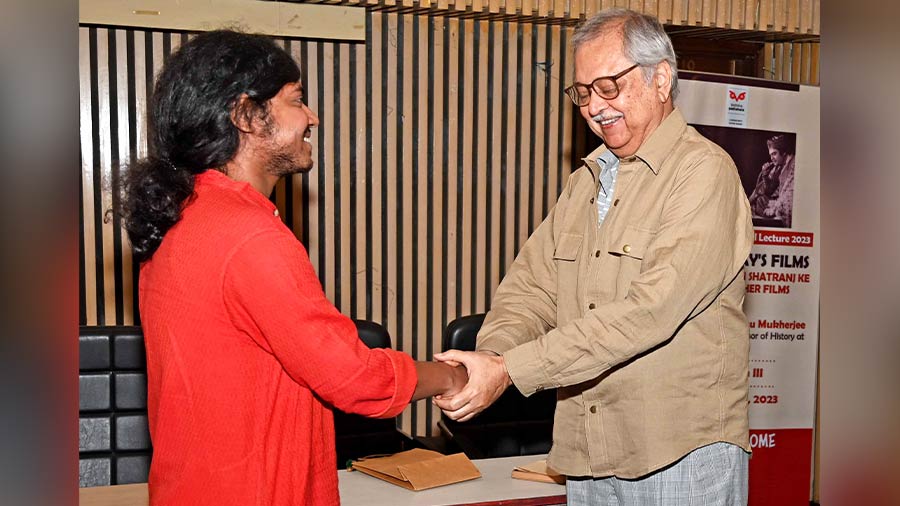
Visual artist Soumyadeep Roy felicitates Rudrangshu Mukherjee
The power of moving images
Mukherjee confessed, at the very onset, that the subject of his talk was deliberately chosen, as Shatranj Ke Khilari is one of his favourite films. “I had begun my work on Awadh when Ray was beginning to research Shatranj Ke Khilari,” said Mukherjee, who is the author of books such as Awadh in Revolt 1857–58: A Study of Popular Resistance and A Begum and a Rani: Hazrat Mahal and Lakshmibai in 1857. “He happened to be a family friend, and I had the good fortune of discussing Wajid Ali Shah, Awadh and its annexation with him on many occasions.” Mukherjee and Ray also watched the London premiere of the film together, when the former was studying at Oxford. “I have shared a deep, personal bond with the maker of the film, and the film itself.”
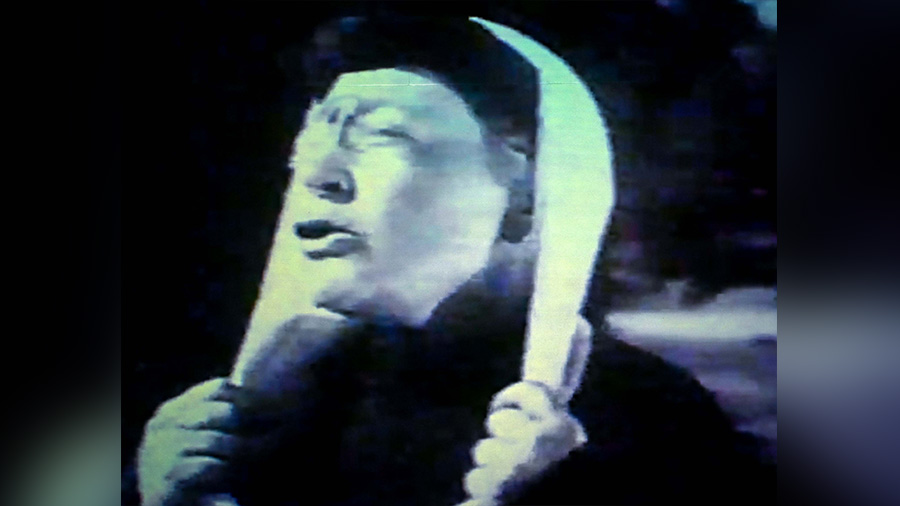
A still from the famous scene depicting a massacre on the Odessa Steps in Sergei Eisenstein’s 1925 silent film, ‘Battleship Potemkin’
And while the focus of the lecture was Shatranj Ke Khilari, to illustrate the sheer power of filmmaking, Mukherjee began by showing the audience a clip from Sergei Eisenstein’s 1925 film, Battleship Potemkin. It was the famed Odessa Steps sequence, which remains one of the most cited examples of montage filmmaking in the history of cinema. “This scene, imprinted in our minds as a major episode in the history of the Russian Revolution, is supposed to be what has come to be called Bloody Sunday – 9 January 1905, according to the Julian calendar – described by Lenin as ‘the dress rehearsal for the Russian Revolution’,” said Mukherjee.
The interesting thing? While Bloody Sunday did happen, the massacre on the Odessa Steps, as shown in the film, did not. “And yet, when we think of the 1905 Revolution, all film buffs think of this sequence,” he said. “It never happened, but the power of moving images has imprinted this scene in our minds as history. That is the power of moving images – the sequence captures the spirit of what happened on Bloody Sunday, even though the event itself did not occur. It captures the tension between history and cinema — the tension between facts and creativity; how much liberty can artists take with historical facts or context?”
‘Not even a millimetre of deviation from history’
This provided the perfect segue into the next segment of the lecture: how Ray, through Shatranj Ke Khilari, resolves the tension between history and creative imagination, by using the latter to remain true to the spirit of the age – in this case, late January/early February 1856, when the British were contemplating, and then carrying out, the annexation of Awadh. Mukherjee played for his audience the animated clip a few minutes into the film, where Lord Dalhousie’s views of Wajid Ali Shah as “the wretch at Lucknow” are revealed, and his systematic annexations of Punjab, Burma, Nagpur, Satara and Jhansi are depicted, with Awadh, in Dalhousie’s words, being “the cherry that will drop into our mouths some day”.
“There isn’t even a millimetre of deviation from history in this animated clip,” said Mukherjee. “That is exactly how it happened. It is worth noting that Dalhousie, and the British, thought of Awadh as something to be consumed; in fact, around 1800, Lord Wellesley had promised London ‘a supper of Oudh’. Dalhousie, who had not even met Wajid Ali Shah, described him as a ‘wretch’.”
Who was this so-called ‘wretch’? In a clip, Wajid Ali Shah is shown dancing as the Hindu god, Krishna, while another depicts a conversation between Lord Outram and his aide-de-camp, Captain Weston, in which Outram’s contempt for the Nawab is evident. “A Shia Muslim king dances as Krishna,” Mukherjee says. “When his 9-year-old son was put on the throne by the rebels of 1857, they danced around him – Hindu sepoys around a Muslim king – singing ‘you are our Kanhaiyya’, harking back to his father, who had danced as Krishna.” And while this portion is not part of the movie, as Ray did not directly go into the events of 1857, the visual of Wajid Ali Shah dancing showed, as Mukherjee said, “a contrast between two different conceptions of kingship”: one in which a monarch writes operas, composes music, “flies kites with his subjects, plays cards with them, dances with them”, and another sort of kingship, espoused by the likes of Outram, Dalhousie and other paladins of empire – “ruthless, efficient, and with no concern for the welfare of the subjects.”
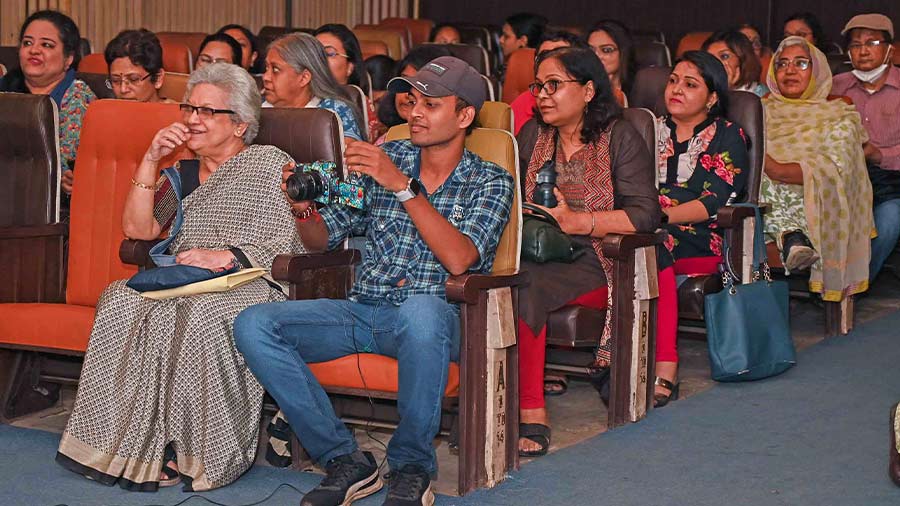
The audience listens to Rudrangshu Mukherjee’s lecture at Nandan III
Wajid Ali Shah: the ‘wretch’ who was loved by his subjects
“Do any of the monarchs of England write music? Do any of their subjects sing their songs?” asked Mukherjee. “They do not. The monarchs of England are modelled differently, particularly after Henry VIII and Thomas Cromwell’s revolution in government, in which the monarch was hidden by an aura of magic. Wajid Ali Shah, on the other hand? When he was exiled, he refused the offer of a carriage to Caunpur. He walked — and behind him walked, as contemporary Awadh chronicles documented, more than 10,000 subjects singing his songs, particularly Jab Chhod Chale Lucknow Nagri.”
“That’s the ‘wretch’... loved by his subjects,” said Mukherjee. This was the contrast that he tried to highlight when he played the aforementioned clips back-to-back. “Ray uses his creative imagination while remaining completely true to history,” he said. “Did Outram and Weston actually have that conversation about Wajid Ali Shah? There is no documentation about it. But we know Outram harboured these sentiments towards the Nawab; so we can imagine him and any aide-de-camp of his having a similar dialogue. Thus, through the use of a creative imagination, Ray constructs a scene to depict what the British had in mind, how they viewed Wajid Ali Shah, and what they intended to do with him in the eventual analysis.”

A memorable moment in ‘Shatranj Ke Khilari’, in which Wajid Ali Shah tells Lord Outram that he can take the Nawab’s crown, but he cannot make him sign the treaty that gives the British administrative control over Awadh
Another clip is played, of the famous scene where the Nawab is given the fait accompli by Outram – that he must sign a new treaty to become a pensioner and cede control over Awadh to the East India Company. In the unforgettable sequence, Wajid Ali Shah holds out his crown to Outram, and says, “You can take my crown, Resident saab, but you cannot make me sign this treaty”.
“If you watch that sequence, you will notice that when Wajid is looking at Weston, Weston cannot meet his gaze,” said Mukherjee. “He knows what is going on; the British are breaking an alliance with a friend. That friend, on his part, had ordered the complete disarming of all the troops in Lucknow when Outram came to see him; he is making a gesture of friendship knowing very well that the Resident is coming to him with more than a gesture of hostility. This sense of honour or dignity was integral to Wajid Ali Shah’s sense of kingship, and the idea of how a king should behave.”

Kallu watches the British troops from Caunpur march into Lucknow in ‘Shatranj Ke Khilari’
‘Ray saw the India Office Library scroll, and recreated it as cinema’
In a final depiction of Ray’s extraordinary ability to remain true to history in his filmmaking, Mukherjee played the clip of British troops marching into Lucknow from Caunpur on the morning of 5 February, 1856. In the clip, we observe the order in which the troops and their animals march – the exact sequence of which was taken, as Mukherjee revealed, from a very detailed scroll preserved in the India Office Library, now part of the British Library, in London. “Ray saw that scroll, and then recreated it as cinema,” said Mukherjee. “That is how close he was to history.”
That scene also showed Kallu, the young boy, standing behind a boulder and watching the troops march into Lucknow. “The first thing that strikes me when I see that little boy, hiding behind the boulder and watching the troops, is Apu from Aparajito,” said Mukherjee, reminding the audience of Apu looking in wonder at the Dashashwamedh Ghat in Varanasi. But, more importantly, “there is a glint in Kallu’s eye that is not just wonder,” he said. “Is Ray suggesting something? Is he just, for a moment, in a flicker that only cinema can capture, jumping from 1856 to 1857?”
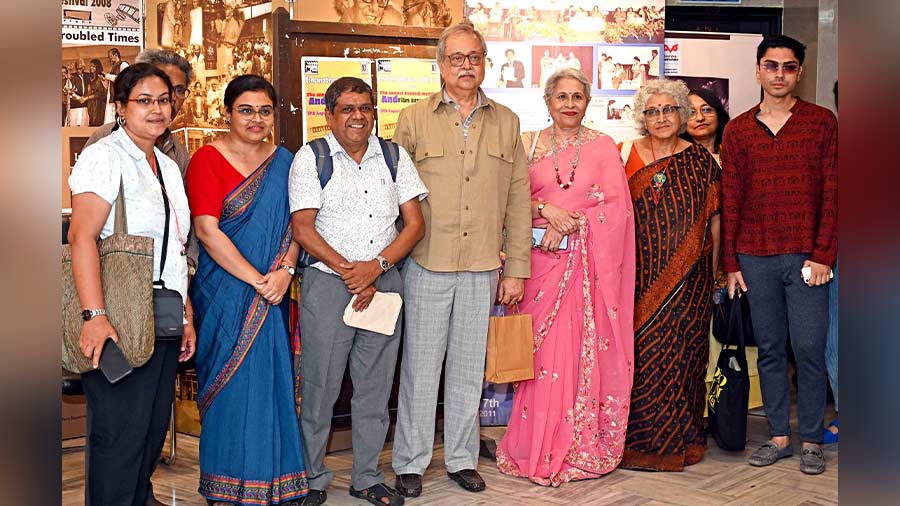
Rudrangshu Mukherjee with (to his left) Vaijayanti Bose and the founder of Bichitra Pathshala, Subha Das Mollick, at Nandan III
“Kallu is to grow up; he is the future,” points out Mukherjee, as the lecture nears its end. “In his eyes, we, perhaps, see a glimmer of what the British are going to face in 1857 — an integral part of the history of Awadh, and also the legacy of Wajid Ali Shah.” After all, Begum Hazrat Mahal becomes the leader of the rebellion in Awadh, and her son with the Nawab becomes the king of Awadh for a year during the rebellion. “So Ray is absolutely true to history; but when he steps out of it, and uses his creative imagination, he is not distorting history. He maintains that tension between cinema and history – and, in a way, resolves it.”




